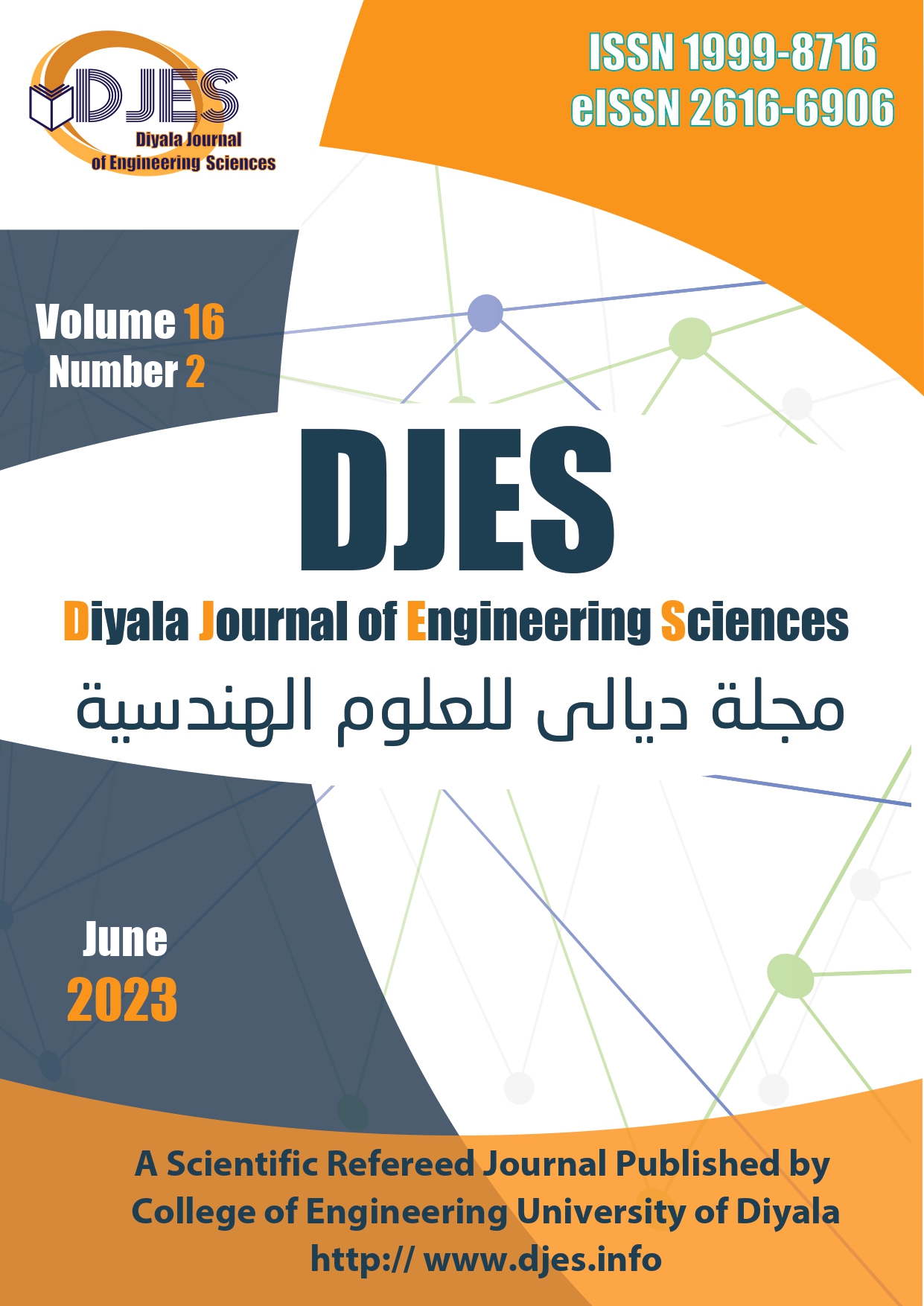Design and Optimization of a Standing-Wave Thermoacoustic Refrigerator Using DELTAEC
DOI:
https://doi.org/10.24237/djes.2023.16211Keywords:
Thermoacoustic refrigerator, COP, stack, resonator, DELTAECAbstract
Thermoacoustic refrigeration is among the best alternatives to conventional refrigeration systems because of the use of inert gases for instance helium or air. On the contrary, refrigerants used in some conventional refrigeration systems are very harmful to the ozone layer and can contribute to global warming problems. In addition, in the event of their leakage, they cause harm to humans. Thermoacoustic technology can be described as a clean, renewable technology. The thermoacoustic refrigerator's main function is to utilize sound waves to create a cooling effect. The aim of this research is to design a standing wave thermoacoustic refrigerator driven by an acoustic driver using the simulation program DELTAEC to achieve high cooling capacity and improve the coefficient of performance. In addition, it discusses the design process. Besides that, the influence of significant stack and resonator parameters (inertance and compliance) is discussed in order to assist thermoacoustic researchers in better understanding and designing the thermoacoustic refrigerator. According to the results obtained, the designed thermoacoustc refrigerator performed best. It has achieved a cooling load (cooling capacity) of 312W and a COP of 1.9275 at a difference in temperature of 25K between the AHX and CHX.
Downloads
References
M. A. Alamir and N. A. C. Sidik, “Thermoacoustic Refrigerators and Heat Pumps: New Insights for A High Performance,” J. Adv. Res. Fluid Mech. Therm. Sci., vol. 78, no. 1, pp. 146–156, 2021.http://dx.doi.org/10.37934/arfmts.78.1.146156
D. Johari, E. M. Mattokit, and F. A. Z. M. Saat, “Parametric Study of Thermoacoustic System using DeltaE,” J. Adv. Res. Fluid Mech. Therm. Sci., vol. 46, no. 1, pp. 161–168, 2018.https://akademiabaru.com/submit/index.php/arfmts/article/view/2216
A. B. Desai, K. P. Desai, H. B. Naik, and M. D. Atrey, “Optimization of thermoacoustic engine driven thermoacoustic refrigerator using response surface methodology,” in IOP Conference Series: Materials Science and Engineering, 2017, vol. 171, no. 1, p. 12132.doi:10.1088/1757-899X/171/1/012132
G. Swift, “Thermoacoustics: A unifying perspective for some engines and refrigerators. Fifth draft,” Los Almos Natl. Lab., 2001.
O. S. Mahmood, A. M. A. Karim, S. G. Yahya, and I. D. J. Azzawi, “Miniaturized Traveling-Wave Thermoacoustic Refrigerator Driven by Loudspeaker: Numerical Design,” Int. J. Air-Conditioning Refrig., vol. 28, no. 04, p. 2050035, 2020. https://doi.org/10.1142/S2010132520500352
T. Tiwatane and S. Barve, “Thermoacoustic Effect: the Power of Conversion of Sound Energy & Heat Energy,” Int. J. Res. Technol. Stud., vol. 1, no. 4, pp. 20–28, 2014.
I. A. Ramadan, H. Bailliet, G. Poignand, and D. Gardner, “Design, manufacturing and testing of a compact thermoacoustic refrigerator,” Appl. Therm. Eng., vol. 189, p. 116705, 2021. https://doi.org/10.1016/j.applthermaleng.2021.116705
N. Rott, “Thermoacoustics,” Adv. Appl. Mech., vol. 20, pp. 135–175, 1980. https://doi.org/10.1016/S0065-2156(08)70233-3
S. Backhaus and G. W. Swift, “A thermoacoustic-Stirling heat engine: Detailed study,” J. Acoust. Soc. Am., vol. 107, no. 6, pp. 3148–3166, 2000. https://doi.org/10.1121/1.429343
M. E. H. Tijani, Loudspeaker-driven thermo-acoustic refrigeration. PhD thesis Technische Universiteit Eindhoven Eindhoven, Netherlands, 2001. https://doi.org/10.6100/IR547542
N. Putra and D. Agustina, “Influence of stack plate thickness and voltage input on the performance of loudspeaker-driven thermoacoustic refrigerator,” in Journal of Physics: Conference Series, 2013, vol. 423, no. 1, p. 12050.http://dx.doi.org/10.1088/1742-6596/423/1/012050
L. K. Tartibu, “A sustainable solution for refrigeration using thermo-acoustic technology (March 2016),” in 2016 International Conference on the Domestic Use of Energy (DUE), 2016, pp. 1–8. http://dx.doi.org/10.1109/DUE.2016.7466714
B. G. Prashantha, D. R. Swamy, B. Soragaon, and T. S. Nanjundeswaraswamy, “Design optimization and analysis of thermoacoustic refrigerators,” Int. J. Air-Conditioning Refrig., vol. 28, no. 03, p. 2050020, 2020. https://doi.org/10.1142/S2010132520500200
N. A. Zolpakar, N. Mohd-Ghazali, and M. H. El-Fawal, “Performance analysis of the standing wave thermoacoustic refrigerator: A review,” Renew. Sustain. energy Rev., vol. 54, pp. 626–634, 2016. https://doi.org/10.1016/j.rser.2015.10.018
C. Wantha and K. Assawamartbunluea, “The impact of the resonance tube on performance of a thermoacoustic stack,” Front. Heat Mass Transf., vol. 2, no. 4, 2012. http://dx.doi.org/10.5098/hmt.v2.4.3006
N. Atiqah Zolpakar, N. Mohd-Ghazali, and R. Ahmad, “Optimization of the stack unit in a thermoacoustic refrigerator,” Heat Transf. Eng., vol. 38, no. 4, pp. 431–437, 2017. http://dx.doi.org/10.1080/01457632.2016.1195138
S. G. Yahya, X. Mao, and A. J. Jaworski, “Experimental investigation of thermal performance of random stack materials for use in standing wave thermoacoustic refrigerators,” Int. J. Refrig., vol. 75, pp. 52–63, 2017. http://dx.doi.org/10.1016/j.ijrefrig.2017.01.013
M. A. Alamir, “Experimental study of the stack geometric parameters effect on the resonance frequency of a standing wave thermoacoustic refrigerator,” Int. J. Green Energy, vol. 16, no. 8, pp. 639–651, 2019. http://dx.doi.org/10.1080/15435075.2019.1602533
M. E. H. Tijani, J. C. H. Zeegers, and A. De Waele, “The optimal stack spacing for thermoacoustic refrigeration,” J. Acoust. Soc. Am., vol. 112, no. 1, pp. 128–133, 2002. https://doi.org/10.1121/1.1487842
N. A. Zolpakar and N. Mohd-Ghazali, “Comparison of a Thermoacoustic Refrigerator Stack Performance: Mylar Spiral, Celcor Substrates and 3D Printed Stacks,” Int. J. Air-Conditioning Refrig., vol. 27, no. 03, p. 1950021, 2019. https://doi.org/10.1142/S2010132519500214
L. K. Tartibu, “Maximum cooling and maximum efficiency of thermoacoustic refrigerators,” Heat Mass Transf., vol. 52, no. 1, pp. 95–102, 2016. http://dx.doi.org/10.1007/s00231-015-1599-y
J. Kajurek, A. Rusowicz, and A. Grzebielec, “Design and simulation of a small capacity thermoacoustic refrigerator,” SN Appl. Sci., vol. 1, no. 6, pp. 1–9, 2019. https://link.springer.com/article/10.1007/s42452-019-0569-2
N. V Shivakumara and A. Bheemsha, “Performance Analysis of Thermoacoustic Refrigerator of 10 W Cooling Power made up of Poly-Vinyl-Chloride for Different Parallel Plate Stacks by using Helium as a Working Fluid,” J. Therm. Sci., vol. 30, no. 6, pp. 2037–2055, 2021.
P. Bansal, E. Vineyard, and O. Abdelaziz, “Status of not-in-kind refrigeration technologies for household space conditioning, water heating and food refrigeration,” Int. J. Sustain. Built Environ., vol. 1, no. 1, pp. 85–101, 2012. https://doi.org/10.1016/j.ijsbe.2012.07.003
M. E. H. Tijani, J. C. H. Zeegers, and A. De Waele, “Design of thermoacoustic refrigerators,” Cryogenics (Guildf)., vol. 42, no. 1, pp. 49–57, 2002. http://dx.doi.org/10.1016/S0011-2275(01)00179-5
Z. Bouramdane, A. Bah, M. Alaoui, and N. Martaj, “Numerical analysis of thermoacoustically driven thermoacoustic refrigerator with a stack of parallel plates having corrugated surfaces,” Int. J. Air-Conditioning Refrig., vol. 30, no. 1, pp. 1–19, 2022. https://link.springer.com/article/10.1007/s44189-022-00002-8
H. Babaei and K. Siddiqui, “Design and optimization of thermoacoustic devices,” Energy Convers. Manag., vol. 49, no. 12, pp. 3585–3598, 2008. https://doi.org/10.1016/j.enconman.2008.07.002
C. Herman and Y. Chen, “A simplified model of heat transfer in heat exchangers and stack plates of thermoacoustic refrigerators,” Heat Mass Transf., vol. 42, no. 10, pp. 901–917, 2006. https://link.springer.com/article/10.1007/s00231-006-0150-6
G. W. Swift, “Thermoacoustic engines,” J. Acoust. Soc. Am., vol. 84, no. 4, pp. 1145–1180, 1988. https://doi.org/10.1121/1.396617
T. J. Hofler, “Thermoacoustic Refrigerator Design and Performance (Heat Engine, Resonator, Microphone),” PhD thesis, University of California, San Diego, 1986. https://www.proquest.com/openview/46e288d402bfc5f48cb23c693bbb17b9/1?pqorigsite=gscholar&cbl=18750&diss=y
M. A. G. Timmer, K. de Blok, and T. H. van der Meer, “Review on the conversion of thermoacoustic power into electricity,” J. Acoust. Soc. Am., vol. 143, no. 2, pp. 841–857, 2018. https://doi.org/10.1121/1.5023395
Z. Yu, P. Saechan, and A. J. Jaworski, “A method of characterising performance of audio loudspeakers for linear alternator applications in low-cost thermoacoustic electricity generators,” Appl. Acoust., vol. 72, no. 5, pp. 260–267, 2011. https://doi.org/10.1016/j.apacoust.2010.11.011
“FaitalPRO | Professional Loudspeakers Made in Italy.” https://faitalpro.com/en/ (accessed Sep. 29, 2022).
M. Yulianto, “Experimental study of thermoacoustic cooling with parallel-plate stack in different distances,” in IOP Conference Series: Materials Science and Engineering, 2019, vol. 539, no. 1, p. 12037. https://doi.org/10.1088/1757899X/539/1/012037
N. M. Hariharan, P. Sivashanmugam, and S. Kasthurirengan, “Influence of stack geometry and resonator length on the performance of thermoacoustic engine,” Appl. Acoust., vol. 73, no. 10, pp. 1052–1058, 2012. https://doi.org/10.1016/j.apacoust.2012.05.003
Z. Yu and A. J. Jaworski, “Optimization of thermoacoustic stacks for low onset temperature engines,” Proc. Inst. Mech. Eng. Part A J. Power Energy, vol. 224, no. 3, pp. 329–337, 2010. https://doi.org/10.1243/09576509JPE845
H. Ke, Y. He, Y. Liu, and F. Cui, “Mixture working gases in thermoacoustic engines for different applications,” Int. J. Thermophys., vol. 33, no. 7, pp. 1143–1163, 2012. https://link.springer.com/article/10.1007/s10765-012-1268-z
W. C. Ward and G. W. Swift, “Design environment for low‐amplitude thermoacoustic engines,” J. Acoust. Soc. Am., vol. 95, no. 6, pp. 3671–3672, 1994. https://doi.org/10.1121/1.409938
Ward B, C. J. and S. G. W. (2012). Design Environment for Low-Amplitude Thermoacoustic Energy Conversion (DeltaEC software). Version 6.3, Los Alamos National Laboratory. https://www.lanl.gov/thermoacoustics
Downloads
Published
Issue
Section
License
Copyright (c) 2023 Mohanad Qays, Samir Gh. YAHYA

This work is licensed under a Creative Commons Attribution 4.0 International License.












